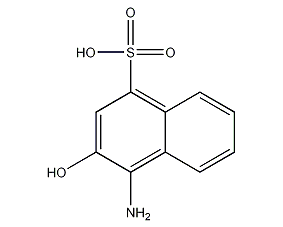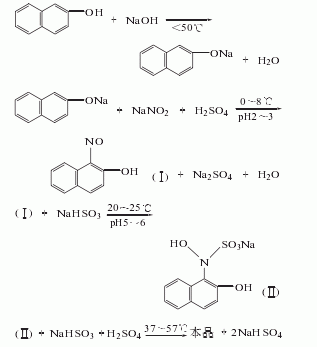
Structural formula
| Business number | 038S |
|---|---|
| Molecular formula | C10H9NO4S |
| Molecular weight | 239.25 |
| label |
1-amino-2-naphthol-4-sulfur, 1,2,4-acid, 1-Amino-2-naphthol-4-sulfonic acid, 1,2,4,-Acid, aromatic sulfur compounds |
Numbering system
CAS number:116-63-2
MDL number:MFCD00004019
EINECS number:204-147-3
RTECS number:QK1292000
BRN number:2697469
PubChem number:24864776
Physical property data
1. Properties: White or gray needle-like crystals, often containing half a molecule of crystal water. It changes color easily when exposed to light.
2. Density (g/mL, 20℃): Undetermined
3. Relative vapor density (g/mL, air=1): Undetermined
4. Melting point (ºC): 290 (decomposition)
5. Boiling point (ºC, normal pressure): Undetermined
6. Boiling point (ºC, KPa): Undetermined
7. Refractive index: Undetermined
8. Flash point (ºC): Undetermined
9. Specific rotation (º): Undetermined
10. Autoignition point or ignition temperature (ºC): Undetermined
11. Vapor pressure (mmHg, ºC): Undetermined
12. Saturated vapor Pressure (kPa, ºC): Undetermined
13. Heat of combustion (KJ/mol): Undetermined
14. Critical temperature (ºC): Undetermined
15. Critical pressure (KPa): Undetermined
16. Log value of oil-water (octanol/water) distribution coefficient: Undetermined
17. Explosion upper limit (%, V/V): Undetermined
18. Lower explosion limit (%, V/V): Undetermined
19. Solubility:Insoluble in water, ethanol, ether and benzene, soluble in alkali and sodium sulfite solution. Turns pink in the air, even more so when humid. Alkaline solutions quickly oxidize to brown in the air, and neutral solutions show slightly blue fluorescence.
Toxicological data
Main irritating effects:
On skin: Irritation to skin and mucous membranes.
On eyes: Irritation effects
Sensitization: No known sensitizing effects.
Ecological data
General remarks
Water hazard class 1 (German regulations) (self-assessment via list) The substance is slightly hazardous to water.
Do not allow undiluted or large amounts of product to come into contact with groundwater, waterways or sewage systems.
Do not discharge materials into the surrounding environment without government permission.
Molecular structure data
1.Molar refractive index: 59.80
2, Molar volume (cm3/mol): 147.0
3, Isotonic specific volume (90.2K): 448.3
4. Surface tension (dyne/cm): 86.4
5. Polarizability (10-24cm3): 23.70
Compute chemical data
1. Reference value for hydrophobic parameter calculation (XlogP): 0.9
2. Number of hydrogen bond donors: 3
3. Number of hydrogen bond acceptors: 5
4. Number of rotatable chemical bonds: 1
5. Number of tautomers: 13
6. Topological molecule polar surface area 109
7. Number of heavy atoms: 16
8. Surface charge: 0
9. Complexity: 350
10. Number of isotope atoms: 0
11. Determine the number of atomic stereocenters: 0
12. Uncertain number of atomic stereocenters: 0
13. Determine the number of chemical bond stereocenters: 0
14. Number of uncertain chemical bond stereocenters: 0
15. Number of covalent bond units: 1
Properties and stability
1. Stable at room temperature and pressure, avoid contact with strong oxidants.
2. Toxic. Detailed toxicity has not been reported. Good ventilation should be maintained at the production site, and operators should wear protective equipment.
3. It is irritating to the eyes, respiratory system and skin. Appropriate protective clothing should be worn when used in large quantities.
Storage method
1. This product should be sealed, dry and protected from light.
2. Packed in wooden barrels lined with plastic bags, with a net weight of 40kg per barrel. Store in a dark, dry warehouse away from heat and moisture. Store and transport according to regulations on toxic chemicals.
Synthesis method
1. Using 2-naphthol as raw material, it is obtained by alkali fusion, nitrosation and sulfonation. Raw material consumption quota: 2-naphthol (99%) 840kg/t, sodium bisulfite (98%) 1500kg/t, sulfuric acid (92.5%) 1600kg/t. 2.Dissolve β-naphthol and sodium hydroxide in water at a ratio of 1:1 (molar ratio), heat if necessary, the temperature should not exceed 50°C, completely After dissolving, cool to 0°C, add sodium nitrite solution in the same amount (molar ratio) as β-naphthol while stirring, then slowly add 40% sulfuric acid at 0°C to a pH value of 2 to 3, and control the temperature not to exceed 5℃, let it stand after adding sulfuric acid, filter it after the precipitation is complete, wash the precipitate with water, the resulting precipitate is 1-nitroso-2-naphthol, add water and stir into a paste, adjust ph=6~7, add sulfurous acid at a time For sodium hydrogen solution, control the temperature at 50°C and stir until it is completely dissolved. Dilute the filtrate obtained by filtration with water and slowly add concentrated sulfuric acid while stirring. Stir evenly and let it stand for 4 to 6 hours. Filter and wash the resulting crystals with water several times and dry. to constant weight, which is the finished product 1-amino-2-naphthol-4-sulfonic acid.
The process reaction formula is:
Purpose
1. Reagents for spectrophotometric determination of silicon. Determination of phosphates and silicates (used as reducing agents for heteropolyacids). Indirect determination of calcium. Used as reducing agent for phosphomolybdic acid and silicomolybdic acid. Manufacture of azo dyes.
2.Used for colorimetric determination of phosphate and calcium salts. It is also an intermediate for acidic mordant dyes and acidic complex dyes. Used to produce acidic complex pink B; acidic medium black R and acidic complex salt GGN; acidic medium jujube BN, etc.
3. Used as analytical reagents, such as reducing agents for photometric determination of phosphorus and silicon. Also used as organic synthesis intermediates.

 微信扫一扫打赏
微信扫一扫打赏

